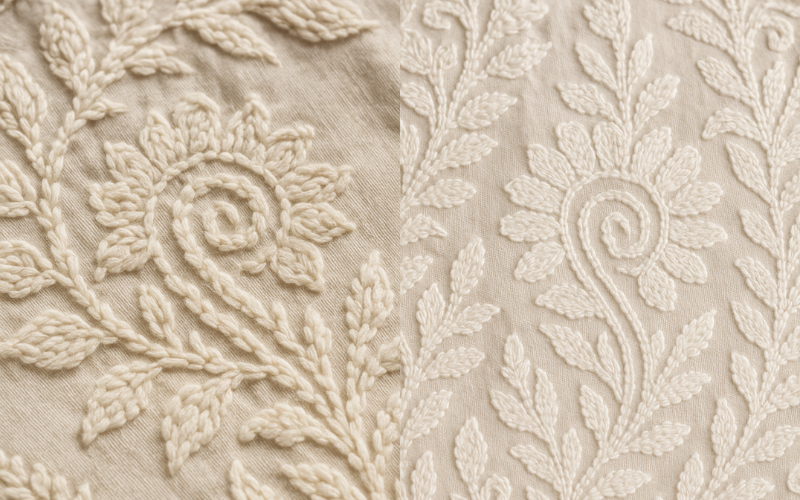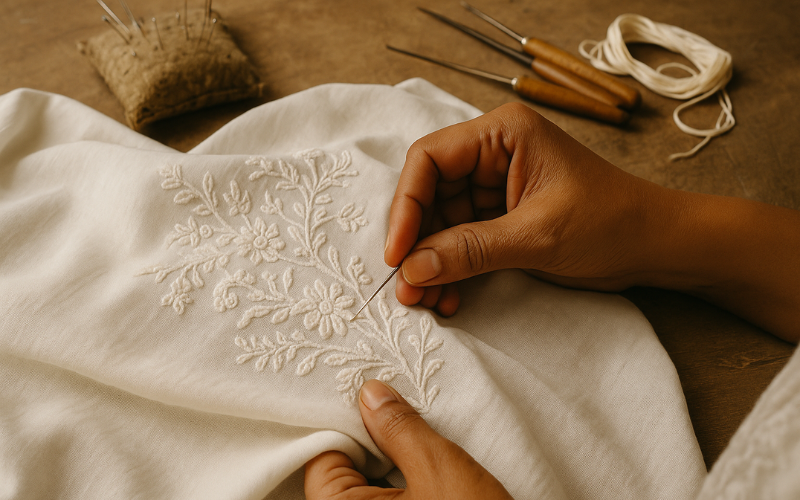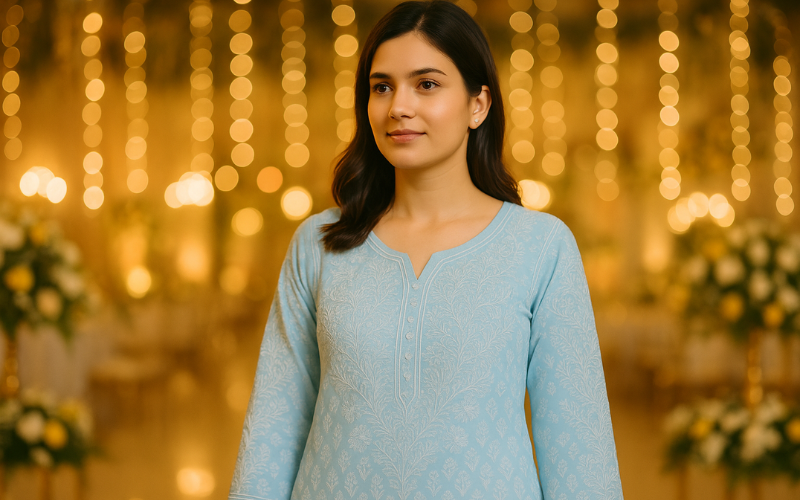Handmade vs Machine-Embroidered Chicken Kari Shirts Guide
Updated: 07 Jul 2025
Chicken Kari more traditionally known as Chikankari is one of the most beloved forms of embroidery in South Asian fashion, celebrated for its delicate, timeless beauty and versatility. Whether you’re a lover of elegant Pakistani summer shirts or searching for the perfect kurti design, you’ve probably encountered the big debate: handmade vs. machine-embroidered Chicken Kari shirts.
But which option truly deserves a spot in your wardrobe? Let’s explore the differences, pros, and cons to help you make an informed, stylish choice.

What is Chicken Kari (Chikankari) Embroidery?
Chikankari (often called Chicken Kari or Chickenkari in Pakistan) is a centuries-old embroidery technique originating from Lucknow, India, and has become a staple in Pakistani and South Asian fashion.
Traditionally worked on airy, lightweight fabrics like cotton, lawn, muslin, and georgette, Chicken Kari features floral motifs, paisleys, vines, and intricate geometric patterns.
Why is Chicken Kari so popular?
- It’s perfect for the sweltering South Asian summers, as the openwork makes the shirts light and breathable.
- The subtle, sophisticated look is ideal for everything from everyday wear to festive occasions.
- Its rich heritage and association with traditional attire make it a wardrobe must-have for many.
What Are Handmade Chicken Kari Shirts?
Handmade Chicken Kari shirts are the gold standard of traditional craftsmanship. Here’s what sets them apart:
The Handmade Process
Each piece is meticulously embroidered by skilled artisans, often women who have learned the craft over generations. The process includes:
- Tracing the design on fabric.
- Hand-embroidering with fine thread using various Chikankari stitches (like bakhiya, phanda, murri, and more).
- Washing and finishing for a soft, lived-in look.
Why Go Handmade?
- Unique Craftsmanship: No two handmade Chicken Kari shirts are identical; every piece carries the artisan’s personal touch.
- Time & Skill Intensive: A single shirt can take days or even weeks to complete, depending on design complexity.
- Traditional Significance: Handmade embroidery is seen as a work of art and a nod to cultural heritage.
Key Features of Handmade Chicken Kari Shirts:
- Slight irregularities or variations signs of authenticity.
- Softer, more organic look and feel.
- Greater depth and variation in stitch work.

What Are Machine-Embroidered Chicken Kari Shirts?
Thanks to technology, Chicken Kari embroidery is no longer limited by time and labor. Enter machine-embroidered Chicken Kari shirts.
The Machine Process
- Digital designs are fed into embroidery machines.
- Automated stitching creates patterns rapidly and uniformly.
- Mass production means thousands of shirts can be made quickly, making these more accessible and affordable.
Why Choose Machine-Embroidered?
- Efficient & Affordable: Lower cost due to faster production and less manual labor.
- Uniform Designs: Every shirt of a design batch looks exactly the same—great for consistency.
- Variety: Fashion brands can release more styles, colors, and patterns at a faster pace.
Key Features of Machine-Embroidered Chicken Kari Shirts:
- Perfectly consistent stitches and motifs.
- Sharper, more defined designs but sometimes less depth or character.
- Budget-friendly pricing for style seekers.
Key Differences: Handmade vs. Machine-Embroidered Chicken Kari Shirts
Let’s compare the two side by side:
| Feature | Handmade Chicken Kari Shirts | Machine-Embroidered Chicken Kari Shirts |
| Quality | Highly detailed, unique, artisanal | Uniform, sharp, but less nuanced |
| Price | Higher due to time and labor | More affordable |
| Durability | Generally more robust if cared for | Good, but thread may snag on some fabrics |
| Appearance | Organic, natural variations, rich texture | Flawless, repetitive patterns |
| Feel | Softer, with gentle, hand-finished touch | Can be slightly stiffer, depending on thread |
| Uniqueness | Every piece is one-of-a-kind | Identical across production batches |
Visual Cues to Identify Each Type
- Handmade: Tiny irregularities, uneven spacing, thicker and thinner areas, slight thread variations.
- Machine: Absolute uniformity, perfect symmetry, repetitive motifs, sometimes a “machine finish” at the back.
Pros and Cons of Each Type
Handmade Chicken Kari Shirts
Pros:
- Unique and authentic no two are exactly alike.
- Superior craftsmanship and cultural value.
- Softer, more comfortable feel over time.
- Supports artisan communities and preserves tradition.
Cons:
- More expensive.
- Time-consuming production means limited designs or slower restocks.
- Requires gentle care to maintain embroidery.
Machine-Embroidered Chicken Kari Shirts
Pros:
- Affordable and accessible for most budgets.
- Wide variety of designs, colors, and sizes.
- Perfect uniformity ideal for matching sets or mass use.
- Faster availability and easy to find in stores.
Cons:
- Lacks the unique charm and irregularity of handwork.
- Some designs may feel flatter or less textured.
- May not have the same heirloom or traditional value.
Which One Should You Choose?
The choice between handmade and machine-embroidered Chicken Kari shirts comes down to your personal style, values, and wardrobe needs.
Consider Handmade If…
- You value heritage, craftsmanship, and unique pieces.
- You want something special for festive events, weddings, or as a collectible.
- You don’t mind investing a little extra for quality and artistry.

Consider Machine-Embroidered If…
- You need affordable, everyday wear or want to keep up with the latest trends.
- You like matching sets for friends or family (e.g., Eid or parties).
- You’re looking for variety in design and color without breaking the bank.
Suitability by Occasion
| Occasion | Handmade Chicken Kari | Machine-Embroidered Chicken Kari |
| Festive/Formal | ✓✓✓ | ✓ |
| Casual/Everyday | ✓ | ✓✓✓ |
| Office Wear | ✓ | ✓✓✓ |
| Gifting | ✓✓✓ (as a luxury gift) | ✓✓ (budget-friendly gift) |
Care Tips for Both Types
Handmade Chicken Kari Shirts
- Hand wash gently or use a delicate cycle in cold water.
- Avoid harsh detergents and bleach.
- Dry in shade to preserve thread color and fabric.
- Iron on reverse to protect the embroidery.
Machine-Embroidered Chicken Kari Shirts
- Machine wash on a gentle cycle (check label for fabric care).
- Turn inside out before washing to reduce friction.
- Avoid wringing or scrubbing embroidery areas.
- Iron with care or use a pressing cloth.
Conclusion
Both handmade and machine-embroidered Chicken Kari shirts bring a special charm to your wardrobe. If you appreciate heritage and uniqueness, handmade Chicken Kari is worth the investment. If affordability, variety, and ease matter more, machine-embroidered Chicken Kari is an excellent choice.
No matter what you pick, Chicken Kari will always be a timeless classic in Pakistani and South Asian fashion.
Which do you prefer? Share your experience or favorite style in the comments below!
And don’t forget to explore our styling tips and latest kurti collections for more inspiration.
FAQs
How can you tell if Chicken Kari is handmade?
Look for tiny irregularities, slight differences in stitches, and a softer, more organic finish. Handmade pieces may have knots or uneven threads at the back.
Are handmade Chicken Kari shirts worth the extra cost?
If you value uniqueness, traditional craftsmanship, and want a one-of-a-kind piece, absolutely. The higher price reflects the artisan’s skill and time.





